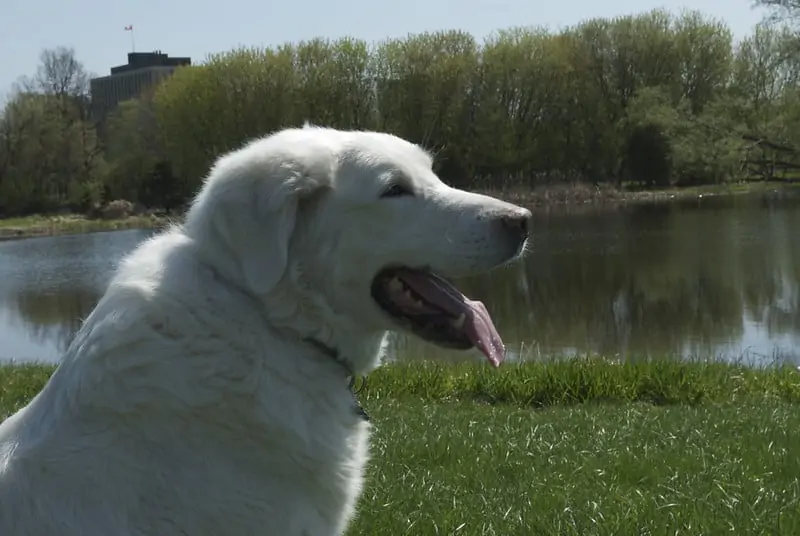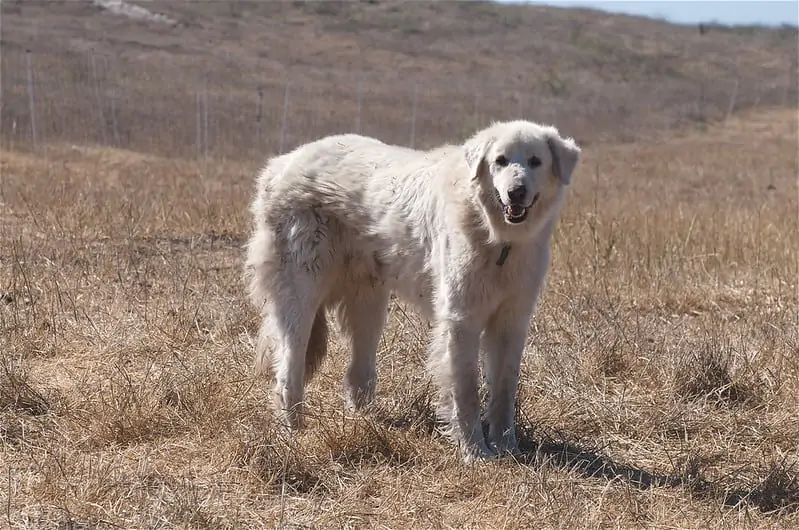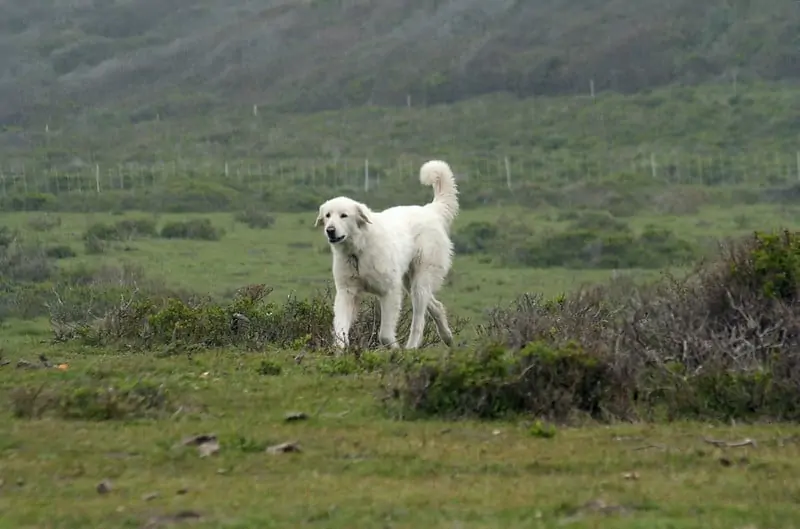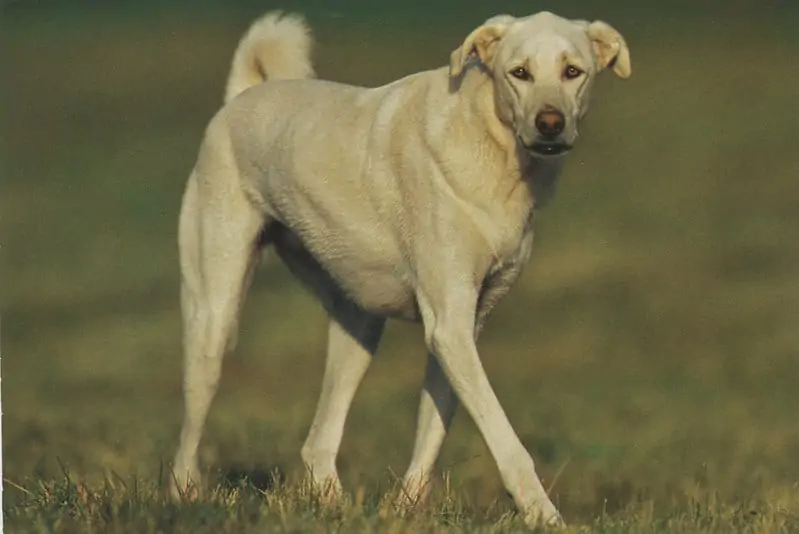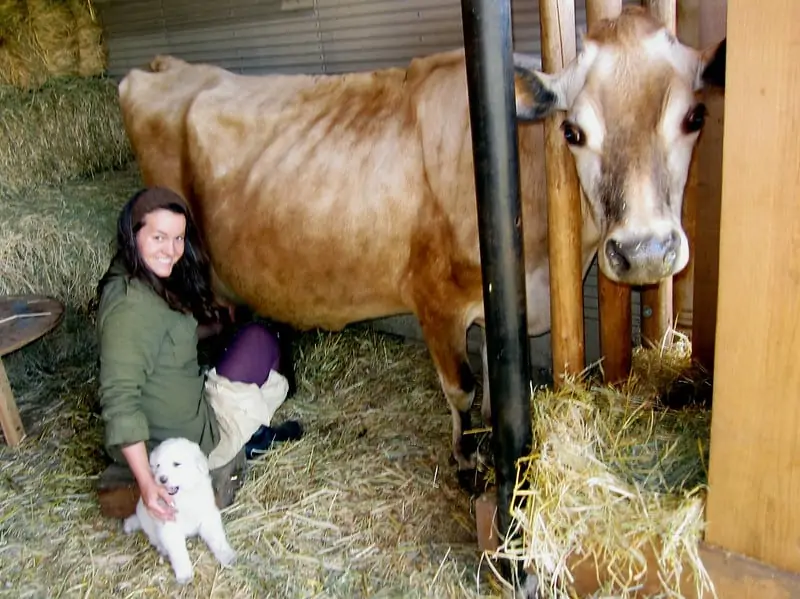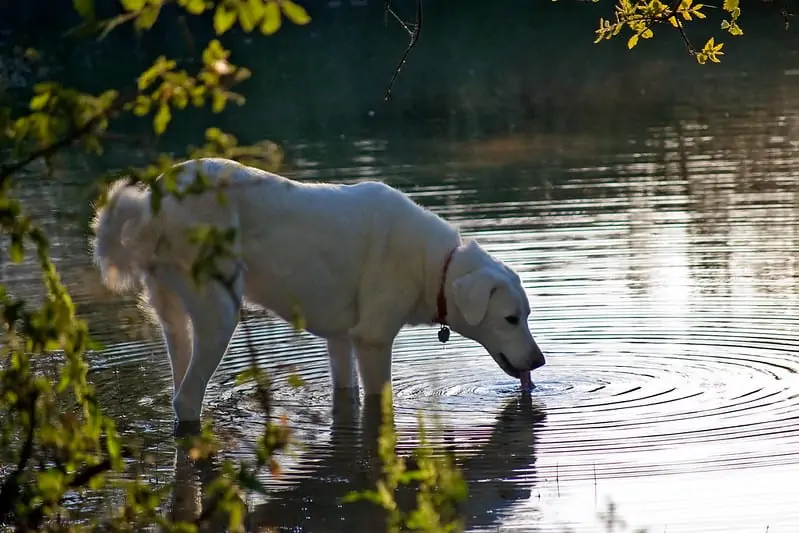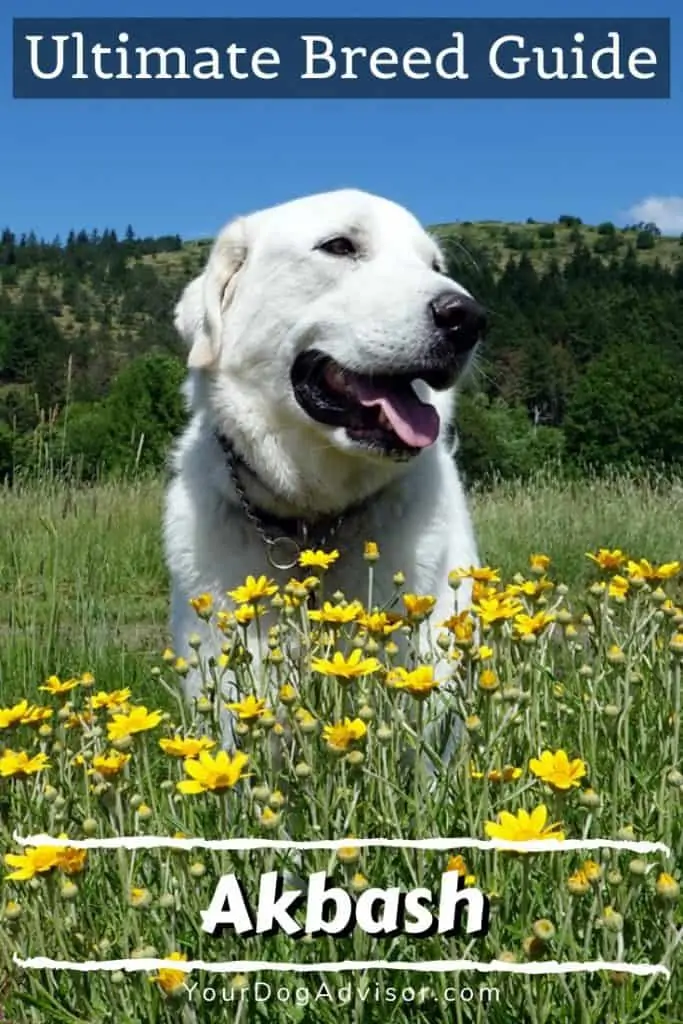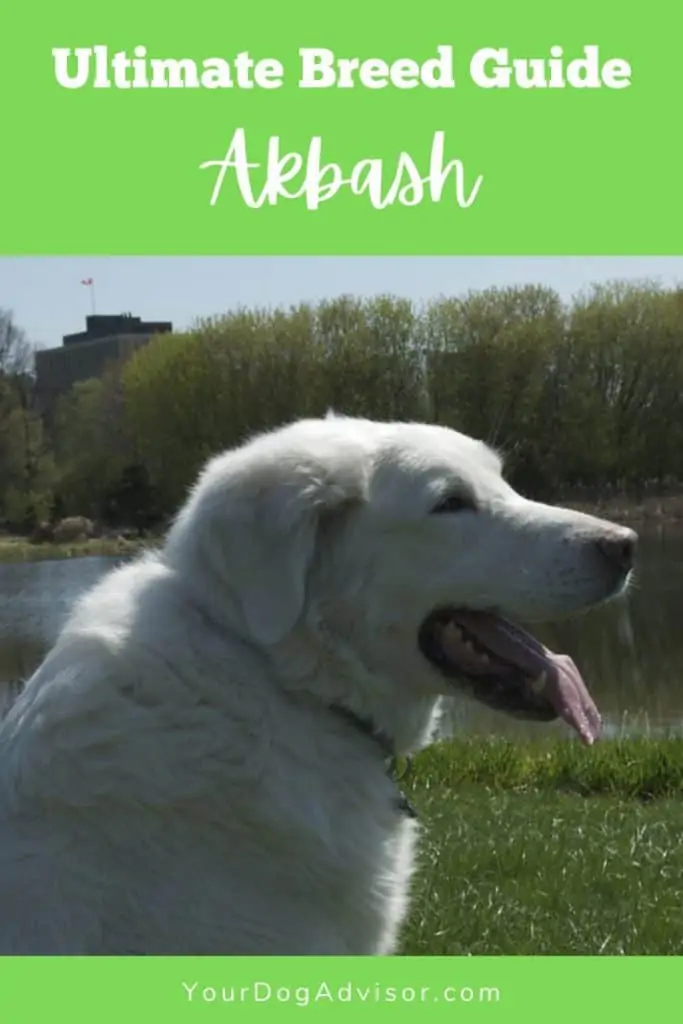The beautiful, substantial Akbash is a loyal breed that is great with children and unflinchingly devoted to their family. But these dogs are also famously independent, stubborn, and prone to escape when home life starts to bore them.
For this complex and sensitive pooch, the right family and lifestyle are everything. Keep reading to find out if you have what it takes to tame this ancient livestock guardian.
The Akbash has a look similar to a Great Pyrenese but with a lighter head, leaner body, and longer legs. Their coat can be smooth or rough, but rarely reaches the length of their Pyrenese cousins. (“DSC_0332” by Delaney Turner / CC BY 2.0)
Contents
General Characteristics of the Akbash
- Other names: Akbaş Çoban Köpeği
- Height: 27 to 32 inches
- Weight: 75 to 140 pounds
- Lifespan: 11 years
- Origin: Turkey
- Colors: White
- Activity level: Low
- Grooming needs: Low to medium
- Best suited for: Easy going families with a lot of space and ranch owners
The History of the Akbash
The Akbash, along with many other livestock guardian type dogs, have been used in Turkey for millennia. Like the Canga and Anatolian, this large dog likely descends from the molosser dogs kept by the Romans.
It is believed that this breed got its taller stature and narrower look by cross-breeding with sighthounds common in the Middle East. This theory is backed up by the fact that Akbashes have incredibly good eyesight.
Livestock guardians were used not for herding or moving flocks, but to protect them.
The Aky is a rugged dog with a thick coat that can withstand the harsh winter but not so thick that it slows them down in the heat. They tend to reserve their energy for confrontation with predators and are not overly active during the day unless they need to be. (“Akbash Dog” by Jerry Kirkhart / CC BY 2.0)
The puppies are raised in the pens with the sheep. Within a few months, these young dogs accept the sheep as part of their pack. Once they hit maturity, a deep-rooted instinct to protect transforms these giant dogs into fierce protectors.
Akbashes are still used primarily as livestock guardians in Turkey today. They are capable of protecting flocks and other types of livestock from wolf packs, large cats, and bears.
Their natural distrust of strangers and unabashed courage has also made these dogs popular as property and family guardians.
Despite having been used in Turkey for centuries, these dogs were not known to the United States until 1970, when researchers in the area took an interest in these intelligent and mysterious white dogs.
After seeing what these dogs were capable of, the researchers brought some back and began breeding them in the US.
About ten years later, the US Department of Agriculture took an interest in the Akbash and other livestock guardians and started studying their use as non-lethal predator determent. After analyzing a decade of data, the Akbash, in particular, was found to be especially effective at preventing predation while being less likely to attack sheep and bite humans.
Despite their success in protecting sheep, goats, and other livestock during the study, Akbashes remain rare outside of Turkey to this day.
The Temperament of the Akbash
Like all livestock guardians, the Akbash is stoic, intelligent, and ever-watchful. They bond strongly with those that surround them in puppyhood–be it sheep or humans. This loyalty is ever-present, but that doesn’t mean these dogs are obedient.
Despite their incredible intelligence–or maybe, because of it–the Akbash is notoriously difficult to train. They prefer making their own deductions of a situation and reacting accordingly rather than listening to someone else’s commands.
When things are as they should be, the Aky is calm, stoic, and usually lounging around. But the moment something appears to be wrong, these observant dogs jump to attention, ready to confront anything that poses a threat to their family. (“Point Buchon Trail” by Teddy Llovet / CC BY 2.0)
It isn’t impossible to get an Aky to listen, but even when they do, it is unlikely to be immediate.
Whether in the home or in the pasture, the Aky tends to be sedentary, choosing a high vantage point and lounging until something demands their attention. Once they spring into action, though, they are quick, powerful, and graceful. They are strong enough to take down a bear and quick enough to outrun wolves.
They are low energy dogs that do not require a lot of physical work. However, failing to provide the Aky with a job or task to occupy their mind will result in escape or destructive behavior. Even when they seem like they are lounging around, their minds are always working and always focused on the job at hand.
The keys to a happy companion Aky are lots of room to roam, a secure fence to keep that roaming from putting them in danger, and having something to protect.
Early socialization produces an Akbash that can happily live with pets of all types, children, and visitors. But no matter how socialized an Aky is, the instinct to guard will always be there.
When faced with a trespasser or predator, they use posturing and barking to warn the intruder off before they give chase. When facing a stranger on their property they may display similar behavior, though most Akys are particularly adept at discerning a threat from a friend. With unthreatening strangers, they tend to be aloof and watchful.
Health Issues Common to the Akbash Breed
A long history of breeding for function over “lines” has created a robust breed with a wide gene pool. In the US, however, the number of breeding Akbashes is more limited and there are some known hereditary health issues you need to be aware of.
In the US, the Aky has taken on a more uniform look, but in its native country of Turkey, these dogs are bred for their ability to guard sheep more than to conform to a specific breed standard. This has led to some dogs having a slightly different look than what most Americans are used to. It is also the reason the breed is not plagued with as many hereditary health problems as other breeds. (“Postcrossing Postcard” by Steve Shook / BY CC 2.0)
Here are a few of the more common health issues found in Akys.
- Hip and elbow dysplasia and other joint issues
- Hypothyroidism
- Epilepsy
- Dilated cardiomyopathy
- Bloat
Like with all breeds, it is important to do extensive research on breeders before committing to buying a new puppy. Akys are rare in the US and truly purebred dogs are even rarer.
Because many livestock guardians look similar but behave in different ways, getting a mixed breed guardian that resembles an Aky doesn’t necessarily mean you will get their calm, loyal, and intelligent personality.
By researching your breeder, asking them questions about the breed and their breeding dogs, and speaking with owners of previous puppies, you can get an idea of what kind of dogs they are producing.
Some breeders are most focused on producing strong and effective working dogs. While others want to create a versatile animal that can do just as well in the house as in the field.
If you want a companion Aky then you need to approach the second type of breeder and work with them to find the right puppy for your home.
Do Akbashes Do Well With Children and Other Pets?
Despite their size and their ferocity in the face of an aggressive predator, livestock guardians are generally great choices for families with children. Akbashes, in particular, are gentle and nonreactive.
When raised with children, these dogs see young ones as part of their pack. They will protect them fiercely while putting up with their less desirable behavior with amazing poise. Akys are also said to have great bite inhibition, meaning they are much less likely than the average pup to bite as a reaction to being startled or injured.
Akys grow to accept any animal they have been raised with as part of their pack. Many breeders make a point to introduce these young dogs to a variety of livestock from day one so that they can easily be used to guard whatever their new owner needs them to. For companion dogs, you will need to extend this exposure to all kinds of household pets to assure a peaceful home as your Aky matures. (“Helping Milk” by fishermansdaughter / CC BY 2.0)
This acceptance of other species into their pack is not just limited to humans and sheep. Akys who are raised with other dogs, cats, and small animals tend to show these siblings just as much tolerance. In fact, many families purchase an Aky as a means to keep their smaller pets safe from predators and large stray dogs.
While generally sociable and gentle with other family dogs, Akys do tend to be dominant. If another dog in the family, especially one that is larger in size, tries to challenge and Aky, there could be trouble.
Usually, these problems sort themselves out, but in extreme cases, one of the dogs may need to be rehomed.
What to Consider Before Bringing Home an Akbash
Are you beginning to think that an independent and calm Aky would be a good addition to your family? Here are a few more things to consider before you start searching for one of these rare dogs.
Activity Level
As adults, Akys are calm and prefer to lay around watching the world. But they still need mental stimulation. Because they do not respond well to instruction and prefer their independence, this can be difficult to accomplish. Long walks, hikes, and plenty of time to romp in a large fenced-in yard is your best bet for calming the Aky mind.
As youngsters, the Aky requires much more physical activity in addition to all this mental stimulation. Daily walks, time to run free, and basic obedience training and socialization will all help tire a teenage Aky out.
Trainability
According to the American Akbash Club, you can teach an Aky a command but you can’t guarantee they’ll listen. This about sums up the trainability of this breed. They will learn new behaviors very quickly, but will only perform them if it suits them at the moment.
The best approach to raising a well behaved Aky is to start the puppy in obedience class early and set up a consistent routine. These dogs love their routines and will reproduce the same behaviors they are used to performing whether asked to or not.
The Aky is a breed that works entirely on instinct. When used for their intended purpose, almost no direct training is involved. For that reason, these dogs struggle with being told what to do. Instead, they prefer to assess the situation and make their own decision on how to act. So long as you provide a consistent routine, they will usually choose the right path. (“Akbash Dogs Blend In” by Jerry Kirkhart / CC BY 2.0)
Grooming
The thick double coat of an Aky can be short or medium length. In either case, the outdoor working hound rarely needs grooming. Inside, though, a good weekly brushing and the occasional bath is a must to keep all that white hair off your floor, especially in the spring and fall.
Like all dogs, Akys need their nails trimmed frequently. Some individuals are born with double dewclaws on the back while others only have one set. In either case, don’t forget to check these nails when performing their bi-monthly pedicure.
Nutrition
The Aky is a lean dog that will do well on any high-quality commercial or home-prepared diet. They tend to be picky eaters and are not prone to overindulging. Still, it is important to keep an eye on your Aky’s weight as any extra pounds will only add stress to their joints.
Cost
Because Akys are primarily bred as working dogs, they are not as expensive as other rare breeds. The average purebred pup will cost you about $700 to $900.
Finding an adoptable purebred Aky is a challenge, but there are plenty of crossbred herd guardians available for adoption each year.
10 Fun Facts About the Akbash
Now that you know what it takes to own an Akbash, here are some fun facts about the breed.
- The Akbash and Kangal may have been crossed to create the more popular Anatolian Shepherd.
- Unlike the Kangal, it is legal for people to export Akbashes from Turkey.
- Akys have been used to guard a variety of livestock including ostriches and miniature horses.
- The Aky is said to display a range of emotions not often seen in most other breeds.
- The Aky has never been used as a herding dog and is even less likely than other guardian breeds to chase livestock.
- Even when faced with an intruder, Akys very rarely bite humans, relying instead on fierce posturing and growling to warn the person away.
- Like the Great Pyrenese, the Aky matures rather quickly compared to other giant breeds.
- While they prefer a large area to roam, Akys are known to stay within their boundaries once they understand where their territory ends.
- Akys have plenty of loose, extra skin around their necks to protect them during conflicts with predators.
- The Akys extremely long legs and flexible back make them incredibly agile and quick.
The long curled tail of the Aky may be a holdover from the sighthounds that went into their creation. It has a similar length and shape as that of the Afghan, Greyhound, and Saluki. (“Dharma Drinking” by Ken Bosma / CC BY 2.0)
Before You Go
Not so sure you have what it takes to turn this pasture guardian into a companion pup? Here are a few more breeds to consider:
“White Dog, Yellow Flowers, Blue Sky” by Bruce Fingerhood / CC BY-NC 2.0
“DSC_0333” by Delaney Turner / CC BY 2.0

Sara Seitz has spent most of her life in the pet industry and has a bachelors in animal behavior from Colorado State University. Sara started working with dogs and cats as a high schooler at a rural boarding kennel. There she learned a lot about the bad and the ugly of the pet service industry. But not even the toughest day at that job would dissuade Sara from following her dream of working with animals.
In college, Sara got a job at a dog daycare and boarding facility in Fort Collins, Colorado. Her new career provided even more opportunities for learning about dog behavior than her classes did. As general manager of the daycare, Sara helped the company launch a new in-home pet sitting branch and trained to become a certified dog trainer. Between shifts taking care of peoples pets in-home and supervising dogs during playtime at the daycare, Sara organized and taught obedience classes.
Sara has always been passionate about bettering the lives of our canine companions. She soon found that advocating for and educating owners in the power of positive reinforcement training was one of the best ways to help dogs and their owners live happier lives.
